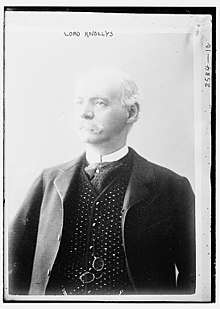Francis Knollys, 1st Viscount Knollys
| The Right Honourable The Viscount Knollys GCB GCVO KCMG ISO PC | |
|---|---|
 | |
| Private Secretary to the Sovereign | |
|
In office 1901–1913 | |
| Monarch |
Edward VII (1901–1910); George V (1910–1913) |
| Preceded by | Sir Arthur Bigge |
| Succeeded by | The Lord Stamfordham |
| Personal details | |
| Born | 16 July 1837 |
| Died | 15 August 1924 (aged 87) |
| Nationality | British |
| Parents |
William Thomas Knollys Elizabeth St Aubyn |
| Alma mater | Royal Military College, Sandhurst |
Francis Knollys, 1st Viscount Knollys, GCB, GCVO, KCMG, ISO, PC (16 July 1837 – 15 August 1924) was a British courtier. He served as Private Secretary to the Sovereign from 1901 to 1913.
Background and education
Knollys was the son of Sir William Thomas Knollys (1797–1883), of Blount's Court at Rotherfield Peppard in Oxfordshire, and was educated in Guernsey. He entered the Royal Military College, Sandhurst, in 1851, and was commissioned into the 23rd Foot as an ensign in 1854.
Career
In the following year, however, Knollys joined the Department of the Commissioners of Audit as a junior examiner. In 1862, he became Secretary to the Treasurer to the Prince of Wales. In 1870, he was appointed Private Secretary to the Prince of Wales, an office he held until the Prince, Edward, became King in 1901. He was also Groom-in-Waiting to the Prince of Wales 1886–1901. Knollys then became Private Secretary to the Sovereign,[1] an office he filled until 1913 (jointly with Arthur Bigge, 1st Baron Stamfordham from 1910[2]). He was known for his loyalty and discretion in this role. He was also Gentleman Usher to Queen Victoria 1868–1901, and a Lord-in-waiting to Queen Mary 1910–1924.
Personal life
Lord Knollys died in August 1924, aged 87. His titles were inherited by his son, Edward George William Tyrwhitt Knollys, 2nd Viscount Knollys (1895–1966).
Honours
Knollys was created a Companion of the Order of the Bath (CB) in 1876, and promoted to Knight Commander (KCB) in 1897 and to Knight Grand Cross (GCB) in 1908. He was also made a Knight Grand Cross of the Royal Victorian Order (GCVO) in 1901, a Knight Commander of the Order of St Michael and St George (KCMG) in 1886, and awarded the Imperial Service Order (ISO) in 1903. In the 1902 Coronation Honours list, it was announced he would receive a barony,[3] and he was raised to the peerage as Baron Knollys, of Caversham in the County of Oxford, on 15 July 1902.[4] He took the oath and his seat in the House of Lords the following month, on 7 August.[5] He became a Privy Councillor in 1910, and in 1911 he was further honoured when he was made Viscount Knollys, of Caversham in the County of Oxford.
- GCB: Knight Grand Cross of the Order of the Bath - 1908 (Knight Commander - KCB 1897; Companion - CB, 1876)
- GCVO: Knight Grand Cross of the Royal Victorian Order - 2 February 1901[6]
- KCMG : Knight Commander of the Most Distinguished Order of St Michael and St George - 1886
- ISO: Imperial Service Order - 1903
References
- ↑ "No. 27283". The London Gazette. 12 February 1901. p. 1058.
- ↑ William M. Kuhn. "Bigge, Arthur John, Baron Stamfordham (1849–1931)". Oxford Dictionary of National Biography (online ed.). Oxford University Press. doi:10.1093/ref:odnb/31883. (Subscription or UK public library membership required.)
- ↑ "The Coronation Honours". The Times (36804). London. 26 June 1902. p. 5.
- ↑ "No. 27455". The London Gazette. 18 July 1902. p. 4587.
- ↑ "The Parliament - House of Lords". The Times (36841). London. 8 August 1902. p. 4.
- ↑ "No. 27285". The London Gazette. 15 February 1901. p. 1145.
- Roderick R. McLean. "Knollys, Francis, first Viscount Knollys (1837–1924)". Oxford Dictionary of National Biography (online ed.). Oxford University Press. doi:10.1093/ref:odnb/34351. (Subscription or UK public library membership required.)
External links
- Hansard 1803–2005: contributions in Parliament by the Viscount Knollys
| Court offices | ||
|---|---|---|
| Preceded by Sir Arthur Bigge |
Private Secretary to the Sovereign 1901 – 1913 |
Succeeded by Sir Arthur Bigge |
| Peerage of the United Kingdom | ||
| New creation | Viscount Knollys 1911 – 1924 |
Succeeded by Edward Knollys |
| Baron Knollys 1902 – 1924 | ||